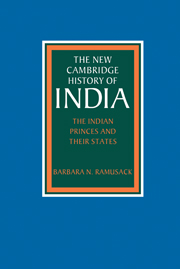Book contents
- Frontmatter
- 1 Introduction: Indian princes and British imperialism
- 2 Princely states prior to 1800
- 3 The British construction of indirect rule
- 4 The theory and experience of indirect rule in colonial India
- 5 Princes as men, women, rulers, patrons, and Oriental stereotypes
- 6 Princely states: administrative and economic structures
- 7 Princely states: society and politics
- 8 Federation or integration?
- Bibliographical Essay
- Glossary
- Index
- THE CAMBRIDGE HISTORY OF INDIA
- References
1 - Introduction: Indian princes and British imperialism
Published online by Cambridge University Press: 28 March 2008
- Frontmatter
- 1 Introduction: Indian princes and British imperialism
- 2 Princely states prior to 1800
- 3 The British construction of indirect rule
- 4 The theory and experience of indirect rule in colonial India
- 5 Princes as men, women, rulers, patrons, and Oriental stereotypes
- 6 Princely states: administrative and economic structures
- 7 Princely states: society and politics
- 8 Federation or integration?
- Bibliographical Essay
- Glossary
- Index
- THE CAMBRIDGE HISTORY OF INDIA
- References
Summary
Air India, the overseas airline of the independent Government of India (GOI), chose a bowing, smiling, turbaned maharaja or prince as its mascot during the 1950s. Why did a democratic government choose this image as an icon for its most modern means of transportation when a decade earlier its prime minister had castigated the princes as rulers whose states were ‘very backward and manyof them… still in the feudal age’? This rotund, red-coated figure epitomises the profoundly ambivalent attitudes towards the Indian princes among successive governments in India. British colonial officials had claimed them as faithful military allies, denounced them as autocrats, praised them as natural leaders of their subjects, chided them as profligate playboys, and taken advantage of their lavish hospitality. During the struggle for independence, Indian nationalists had initially cited the princes as evidence of the ability of Indians to govern effectively; they had occasionally sought their financial patronage of political organisations and collaboration during constitutional negotiations, but ultimately had assailed them as arbitrary autocrats. In independent India and Pakistan, governments have appointed them to positions ranging from state governors to ambassadors; political parties have co-opted erstwhile princes as candidates for the central and state legislatures and appointed them as ministers; public corporations and private entrepreneurs have promoted former princely capitals as destinations for international and domestic tourists; and popular media have represented them as an integral part of Indian culture. In the public sphere, princes were and are portrayed in newspapers, magazines, novels, newsreels and feature films as benevolent paternalists, remnants of feudalism ensconced in romantic forts, sexually ravenous predators, fierce hunters, audacious sportsmen, especially in cricket and polo, and extravagant clients of jewellers and luxury hotels in India and Europe.
- Type
- Chapter
- Information
- The Indian Princes and their States , pp. 1 - 11Publisher: Cambridge University PressPrint publication year: 2003



